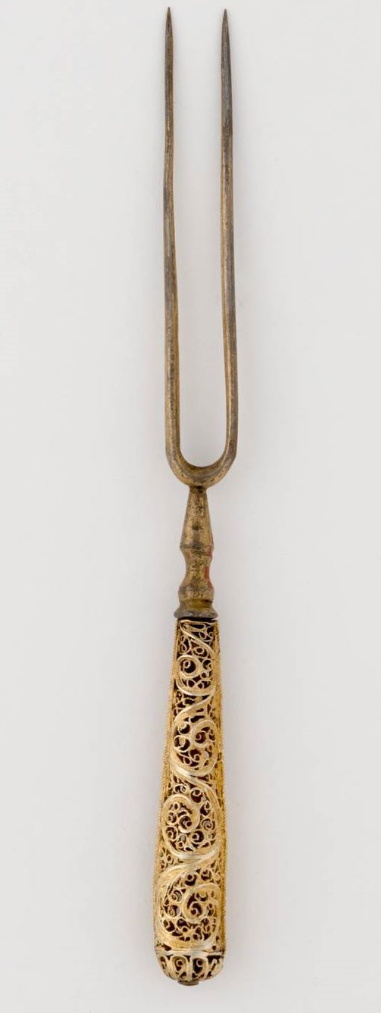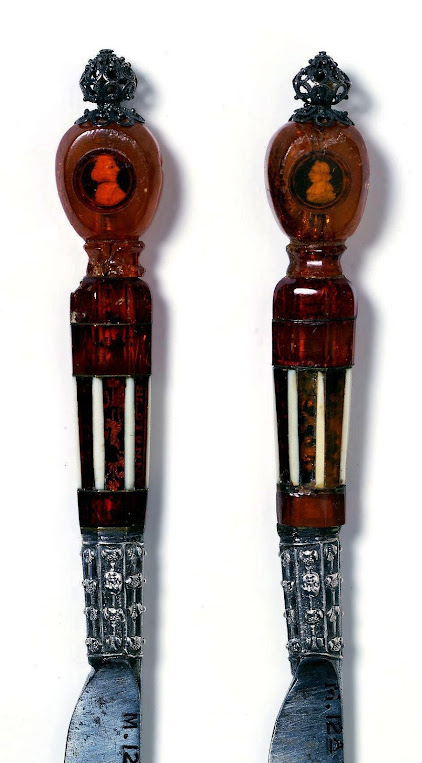Some 18th Century Cutlery with Filigree Handles.
Updated 5 May 2023.
Dr Fischer Auktion. Heilbronn May 2023.
There appears to be a monogram in gold filigree on the handles.
Lot 125. 9 May 2023.
Courtly fork and courtly knife Probably North German, around 1700 Metal and silver, partially gilded. The handles are filigree open worked and set with various glass stones. Knife marked ''AMOS'' on the blade.
L. 17,5 and 20,9 cms.
.........................
17th/18th Century Silver Filigree Handled Knife and Fork Set.
Size, knife 16.7cm, fork 15.2cm.
.........................
Lempertz Erhard Warnberger II, Augsberg.
Length of Spoon 14.5 cms.
Marked for 1697 -99.
Literature Cf. an identical cutlery set by the master in the
Tiroler Landesmuseum, Innsbruck, illustrated by Gertrud Benker, Alte Bestecke,
Munich 1978, no. 181.
Auctioneers - Lempertz, Cologne, Lot 637, 19 May 2023.
.......................
The Globen Auktionhaus Erhard Warnberger II Single Spoon.
Sold 30 Nov 2022.
https://auctionet.com/en/2538140-erhard-warnberger-ii-spoon-silver-augsburg-17th-18th-century
.........................
The Crafoord Erhard Warnberger II Cutlery Set.
Lot 5, Feb. 2023.
Handles in Silver filigree work, blade of the spoon gilded, original
case in embossed leather included. Length: 12-14 cm,
...........................
With Auctioneers Kunsthaus Lempertz. May 2023.
Length of spoon 14.5 cm.
Lot 637 - 17 - 19 May 2023.
An Augsburg silver travel cutlery set.
Comprised of a parcel gilt spoon, two-pronged fork and knife
with silver filigree handles. In the original embossed leather case with
remnants of gilding.
Marks of Erhard II Warnberger, 1697 - 1699.
___________________
A German parcel-gilt and filigree set of travel cutlery, Erhard Warnberger II, Augsburg (1694-1733).
Sold Bukowski
lot 390 Dec 2015
_________________
The Victoria and Albert Museum.
http://collections.vam.ac.uk/item/O108655/knife-and-fork-unknown/
Knife and fork with handles of silver filigree, Northern Germany,
1700-1725.
Knife and fork with partly gilded silver handles decorated
with filigree.; Steel knife with silver filigree handle. The handle is made
from complex open filigree, scattered with granules, over a sheet of gilded
silver. The cap appears to be made from a button of the kind made and worn
traditionally on the western side of Schleswig-Holstein in Germany. This
consists of an open filigree dome with a dense spiral of corded wire in the
centre and three rows of coil rings at the base, separated from the corded wire
by a row of discs, with a single disc in the centre. There is a band of plain
metal between the handle and cap.
'IAB 1723 IGVL' or 'IAB 1793 IGVL' (On the plain band at the
top of the handles.)
In the 17th century it was not yet common for hosts to
provide cutlery when entertaining guests to dinner. Most people of rank had
their own personal eating implements, usually a knife and spoon, with a fork
increasingly included towards the end of the century, which were carried in a
fitted case. Filigree, which became highly fashionable in Europe in the second
half of the 17th century, was often used to decorate these expensive
implements.
In England a cutler would have to prove himself as
bladesmith and hafter (maker of handles) in order to obtain the freedom of the
Worshipful Company of Cutlers, gain his own mark and set up his own business.
For a description and illustration of this kind of cutlery,
see Stierling, Hubert, 'Der Silberschmuck der Nordseeküste', Karl Wachholz
Verlag, Neumünster in Holstein, 1935, p.238 For more examples, see Amme,
Jochen, 'Historische Bestecke', Arnoldsche, 2002, ISBN 3897901676, figs. 540,
541, 542.
....................................
18th Century Knife and Fork with Agate Handles with Filigree Mounts.
Dutch / German.
Marked on the Knife Blade with a cross.
Victoria and Albert Museum.
Length: 17.6cm Length: 17.6cm Maximum width of handle width: 1.2cm.
http://collections.vam.ac.uk/item/O295367/knife-unknown/
......................................
Knife and Fork with Silver Filigree Handles
18th Century
Victoria and Albert Museum.
No size given.
The Museum Website states -
This knife and fork are very similar to the kind of cutlery
made in Augsburg in the late 17th and early 18th centuries. However, the four
prongs on the fork, and the plain band below the top on both pieces, would be
unusual for cutlery of that date. It is more likely that they were made in
Schleswig-Holstein, in north-west Germany, at the end of the 18th century, when
sets of cutlery of archaic form were in common use as wedding gifts. The
initials and date were often inscribed on the plain band.
http://collections.vam.ac.uk/item/O110598/knife-and-fork-unknown/
....................................
Pair of 17th Century Knives.
Silver Filigree Finials
Dated 1638.
Victoria and Albert Museum.
Very important 17th Century examples of dated Filigree.
Given the Amber Handles I suggest Konigsberg - North European / German.
Similar cutlery without the filigree in other collections
Steel blades with amber and ivory handles, silver filigree
finials and silver encrusted ferrules
Pair of wedding knives in an embroidered case, English,
possibly London, dated 1638.
Length: 29.8cm
Handles length: 8.8cm
Marked ANNA MICKLETHWAIT (Handle) ANNO 1638 (Handle)
Bought at Christie's, London, 1 May 1950, lot 143.
http://collections.vam.ac.uk/item/O90755/pair-of-wedding-unknown/
17th/18th century Cutlery set in Leather case.
Augsburg mark c.1700,
Sold by Van Ham Auctioneers, Germany.
...........................
Swedish National Museum.
Knife and Fork Set with Silver Filigree Handles. no 1.(my numbering).
German? 18th Century.
Knife and Fork.
12.2 cms.
_______________
17th Century? Three Piece Cutlery Set with Silver Filigree Handles.
Castilho, M., ‘Oriente – Ocidente 2’, Lisbon, (2010, p. 98) illustrates a knife and fork (with
three tines) with similar filigree work about the handles which he argues is
from India, or at least in part.
A German 17th century silver-gilt and filigree three-piece
travel cutlery, unmarked.
Spoon length 18,5 cm.
Provenance: Esbjörn Kronberg Collection.
_____________
Silver Filigree and Silver Gilt Cutlery Handles.
Skoklosters Castle.
Cutlery with Silver Filigree Handles.
9.8 cms.
https://samlingar.shm.se/object/981D431B-2E7B-4A7E-B037-8E5482682F04
______________
18th Century Silver Filigree and Silver Gilt Fork.
at the Cooper Hewitt Museum.
size - 16.7 cms
https://collection.cooperhewitt.org/objects/18804105/
_____________
Early 18th Century Cutlery Set.
Augsburg.
MAK. Vienna.
https://www.europeana.eu/es/item/15514/GO_1250
_____________________
Single 18th Century North European? Fork with Silver Gilt Filigree Handle.
MAK Vienna.

_______________________
18th Century German? Silver Filigree Handles on a Knife and Fork
with Stockspring Antiques of London 2019.
The blade marked W Lungel.
________________________
Louvre Grand Palais.
Nicolas Bellier, Jacques Du Montie.
__________________
18th Century Cutlery Set.
MAK Museum, Vienna.
The style of the filigree is quite different on this set to the cutlery illustrated above -
suggesting a different area of origin - the cutlery above is all from Northern Europe.
Could this set be Italian or from the Iberian Peninsula??

















.jpg)








.jpg)





















.jpg)























No comments:
Post a Comment